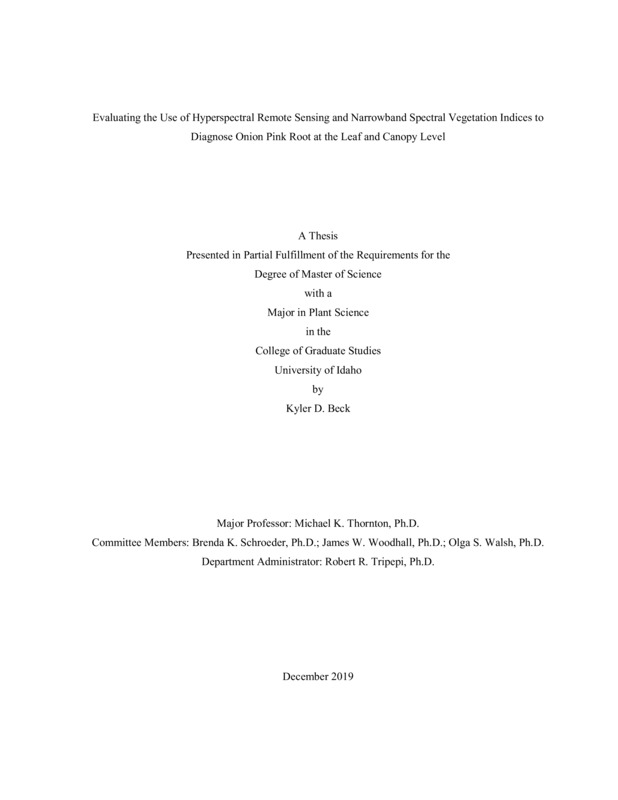Evaluating the Use of Hyperspectral Remote Sensing and Narrowband Spectral Vegetation Indices to Diagnose Onion Pink Root at the Leaf and Canopy Level
Beck, Kyler. (2019-12). Evaluating the Use of Hyperspectral Remote Sensing and Narrowband Spectral Vegetation Indices to Diagnose Onion Pink Root at the Leaf and Canopy Level. Theses and Dissertations Collection, University of Idaho Library Digital Collections. https://www.lib.uidaho.edu/digital/etd/items/beck_idaho_0089n_11716.html
- Title:
- Evaluating the Use of Hyperspectral Remote Sensing and Narrowband Spectral Vegetation Indices to Diagnose Onion Pink Root at the Leaf and Canopy Level
- Author:
- Beck, Kyler
- ORCID:
- 0000-0003-1005-4048
- Date:
- 2019-12
- Keywords:
- Hyperspectral Onion Pink Root Remote Sensing Setophoma terrestris Spectral Vegetation Indices
- Program:
- Plant, Soil and Entomological Sciences
- Subject Category:
- Remote sensing; Plant pathology; Plant sciences
- Abstract:
-
The Treasure Valley of Idaho and Eastern Oregon produces around 30% of the nation’s annual summer storage onion crop. To profitably produce an onion crop, growers must attain both high total yields and bulbs of sufficient size. Onion pink root (causal agent Setophoma terrestris) is capable of destroying the onion root system during the growing season, resulting in foliar symptoms that imitate those of nutrient or drought stress and bulbs that are underdeveloped and small in size. The aim of this study was to evaluate the usefulness of hyperspectral remote sensing and narrowband spectral vegetation indices (SVIs) as a tool to diagnose onion pink root in the field and discriminate its symptoms from those of nitrogen and water stress. A field experiment was established in Parma, ID in 2018 and 2019 to which 3 moderate and consistent individual stress treatments were applied to the onion cultivars SV4643NT and Vaquero. Pink root, nitrogen, and drought stress were imposed using a combination of natural inoculum, soil fumigation (chloropicrin), fertilizer, and drip irrigation. Onion samples and hand-held, hyperspectral radiometric measurements were collected weekly from the time of bulb initiation to the time of plant maturity to study the effects of stress on onion phenotype and reflectance at the leaf and canopy level. Results from the destructive sampling suggest that the proportion of diseased roots is significantly reduced by soil fumigation with chloropicrin. Furthermore, the total nitrogen content of onion leaves sampled from the nitrogen stressed (non-fertilized) plots were significantly reduced from the content of those taken from optimally fertilized plots. All stress treatments significantly reduced plant biomass, although not at the same growth stage nor to the same extent. Reflectance spectra were analyzed using 40 established SVIs. Preliminary analysis determined a similar relative relationship among treatments for most of the SVIs utilized. Three SVIs: triangular vegetation index (TVI), normalized difference vegetation index (NDVI), and optimized soil-adjusted vegetation index (OSAVI) were selected for detailed analysis. Only small variations in SVI value were observed between treatments at the leaf level. At canopy-level, stress treatments consistently lowered index values, though not always significantly and not always to the same degree. Results from standard regression analysis suggest that SVI value is closely related to the biomass of SV4643NT (R2 = 0.67 to 0.79) and Vaquero (R2 = 0.73 to 0.83) onions, likely because of the direct relationship between plant biomass and parameters which account for the fraction of vegetation that covers the soil (such as leaf area index (LAI)). Overall, we found that SVIs, particularly those which include a band in the near-infrared region (700-1000 nm), are overwhelmingly sensitive to variation in canopy LAI as opposed to other vegetation parameters such as plant pigment composition (i.e. chlorophyll) in scenarios where the crop canopy does not completely cover the soil. This presents a challenge to the practical use of hyperspectral remote sensing and narrowband SVIs as a tool to diagnose onion stress at the canopy level.
- Description:
- masters, M.S., Plant, Soil and Entomological Sciences -- University of Idaho - College of Graduate Studies, 2019-12
- Major Professor:
- Thornton, Michael K.
- Committee:
- Schroeder, Brenda K.; Walsh, Olga S.; Woodhall, James H.
- Defense Date:
- 2019-12
- Identifier:
- Beck_idaho_0089N_11716
- Type:
- Text
- Format Original:
- Format:
- application/pdf
- Rights:
- In Copyright - Educational Use Permitted. For more information, please contact University of Idaho Library Special Collections and Archives Department at libspec@uidaho.edu.
- Standardized Rights:
- http://rightsstatements.org/vocab/InC-EDU/1.0/

